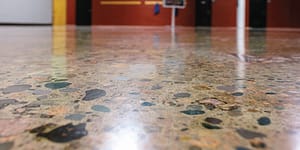
Increasing in popularity in many different settings, polished concrete has become a flexible flooring alternative, from industrial warehouses to modern homes.
Let’s explore the benefits and drawbacks of polished concrete by reviewing these five essential things you should know about polished concrete.
1. Nearly Any Concrete Floor Can Be Polished
With proper preparation, virtually any concrete floor can be polished unless it has significant cracks or is too thin or porous. A professional contractor can assess the condition of the concrete and determine if it’s suitable for polishing.
As a result, it is a highly desirable flooring option in both commercial and residential settings.
While it’s true that nearly any concrete floor can be polished, there are some cases where an existing concrete slab may not be suitable.
For example, if the concrete is severely damaged or has extensive cracking, it may need to be replaced before polishing.
Additionally, if the slab has a high moisture content, it may only be suitable for polishing with additional preparation.
2. Work, Home, and Earth Friendly
Thanks to its reflective finish, polished concrete can brighten up a workplace—literally. This smooth, polished surface will maximize the lighting effects in the area, offering additional visibility in warehouses, kitchens, and other settings where sight is key to avoiding slips and other accidents.
Also, it’s easy to clean and sanitize, making it an ideal flooring choice for businesses handling food and other easily-contaminated materials.
With polished concrete, you only need an existing concrete subfloor, which does not require additional installation materials. From that standpoint, it has a more positive impact on the environment than other flooring options.
On the other hand, multiple steps are involved to achieve a polished concrete floor, including using diamond-impregnated pads of different grits.
Lastly, with stricter sanitation regulations and general caution resulting from the COVID-19 pandemic, the interest in flooring options that are easy to clean has increased significantly, and polished concrete fits the bill perfectly.
3. Durability and Longevity
A polished floor can last for decades with proper care and occasional maintenance. Compared to other flooring options, polished concrete has an extended lifespan, making it a cost-effective choice in the long run.
Furthermore, it’s a durable flooring choice that can withstand heavy foot traffic or equipment use. It doesn’t rip or scuff and is often finished off with a stain protector as a final layer. With proper maintenance, it can last for decades.
However, polishing concrete is a multi-step process that requires specialized equipment and expertise. If the process is not done correctly, it can result in an uneven or inconsistent finish.
Work with a professional with experience in polishing concrete to ensure the job is done right.
4. Easy Upkeep
One of the most significant draws of polished concrete for business owners is that it requires minimal upkeep. A properly-installed polished concrete floor doesn’t need any waxing, and accumulated grime and dirt can be removed easily with a polished concrete floor-safe cleaner.
If a caustic, citric, or acidic liquid stains or etches the floor, it’s simple to remedy. You can use diamond-impregnated pads and cleaners specially formulated to restore the surface, returning your floor to its original condition.
While a polished surface is low-maintenance, it still requires regular cleaning and upkeep to keep it looking its best.
Sweep and mop the floors daily to remove any dirt or debris, and use a specialized cleaner that won’t damage the polished surface. Using floor mats is also recommended to prevent foot traffic and harmful substances from damaging the surface.
However, while generally low-maintenance, resin-bonded or acid-stained floors may require additional care. The finish can be vulnerable to scratches, and acidic substances can cause etching or discoloration.
Follow the manufacturer’s recommendations for maintenance and use appropriate cleaning products.
5. Pros and Cons of Cost
A polished surface is a cost-effective flooring option when considering its long lifespan. Since no additional materials are required for installation, the cost of polished concrete depends on the size of the area and the level of polish desired.
Trowel polishing techniques have made it even more accessible for smaller contractors, allowing them to take on larger concrete polishing jobs more efficiently and productively.
Downsides to Polished Concrete Cost
While polished concrete is an affordable option compared to other types of flooring, it can still be a costly investment depending on the size of the area you’re covering. The cost can vary depending on the degree of shine you’re aiming for, the complexity of the design, and any special treatments or coatings you may choose to apply.
Budgeting accordingly and working with a reputable contractor who can provide an accurate estimate is essential.
Final Thoughts
When considering the cost, it’s important to consider the long-term benefits.
In the end, it’s a durable, work and home-friendly flooring option that can last for decades with proper maintenance, making it a cost-effective choice in the long run.
Runyon is here to help
To explore polished concrete as a flooring option, contact Runyon Surface Prep for equipment, materials, and machinery for your surface preparation needs.
